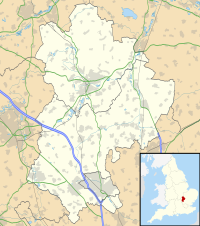| Old Warden Castle | |
|---|---|
Quince Hill | |
| Old Warden, Bedfordshire, England | |
| Coordinates | 52°05′15″N0°20′33″W / 52.08740°N 0.34244°W |
| Grid reference | grid reference TL136445 |
| Type | Castle |
| Site information | |
| Condition | Earthworks |
Old Warden Castle, also known as Quince Hill, is located in the village of Old Warden, in the county of Bedfordshire, England.
Contents
It is uncertain whether it is a motte castle or a ringwork. [1]
Roman and Celtic remains have also been located at the site. [2]
Today, only earthworks remain. These are known locally as Quints or Quince Hill. In 1995 the site was classified as a Scheduled Monument. [1]
